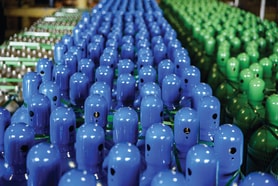Gases in Pulp & Paper: Adding sheen and strength to paper production
The basic building block of all pulp and paper products is a complex organic molecule named cellulose that forms chain-like structures or fibres. The original source of most cellulose fibre used by the pulp and paper industry is wood of several varieties; including both hard and soft woods.
The structural properties of wood, that make it a versatile material with a long history of diverse applications, are derived from these same cellulose fibres.
The cellulose fibres in wood are bound together by an organic substance named lignin. Before cellulose can be re-structured into paper and the extensive range of related products, it is necessary to extract the lignin from the fibres, leaving a wet, fibre rich ‘soup’ known as woodpulp.
Cellulose fibres can be separated from lignin by mechanical methods and the paper and pulp produced this way are referred to as ‘mechanical’ pulp or paper. Mechanical pulp production is less energy intensive than chemical processes, but the fibres suffer mechanical damage leaving them shorter and resulting in lower strength papers that are brittle and discolour quickly.
Chemical pulp production separates the fibres more effectively but the chemicals used are potentially harmful to the environment. Woodpulp produced by any process still has a brown colour imparted by residual lignin and requires bleaching before printing and writing papers can be produced.Bleaching chemicals are even more threatening to the environment.
Chemical pulp mills are effectively operated as closed loop systems, because most of the process chemicals are regenerated onsite and reused. The recovery process also releases sufficient heat energy from exothermic reactions to drive steam turbines and produce most of the electric power needed by the
pulp mill.
In practice however, variations in wood composition, the rate of production and other bottlenecks, imbalances and inefficiencies do occur, at various stages of the recovery process. These events can result in the release of undesirable and harmful compounds into the atmosphere, or wastewater stream and increased operating cost to replace the lost chemicals.
In terms of pulp output, the kraft process yields only about 45% of the mass of wood processed as pulp. About 95% of the lignin is extracted by ‘cooking’ in the Digestor and is absorbed by the white liquor. This biomass is carried in the chemical laden stream that exits from the Brownstock Washer and ultimately burned as fuel in the Recovery Boiler, after the water content has been reduced by the Evaporators.
This combustion process is often compromised by inconsistent flow of viscous black liquor, physical fouling inside the boiler space, variation of liquor composition and flammability, fluctuating thermal output and difficulty in maintaining stoichiometry.
A suite of industrial gas applications have been developed and refined over many years to compensate for these operating inefficiencies. As a result, the Pulp & Paper industry contributes significantly to the industrial demand for oxygen in particular.
Black Liquor Oxidation
Sulphur compounds in black liquor are oxidised by injecting oxygen at an intermediate stage of the multiple effect evaporator. This diminishes the emission of compounds that result in intense odour sensation, like hydrogen sulphide. Sulphur compounds such as sodium sulphide in the black liquor are oxidised to form stable compounds like sodium thiosulfate, thus preventing the formation of TRS (Total Reduced Sulphur) compounds during combustion.
The heat of these oxidation reactions is recovered in the evaporators, boosting energy efficiency and reducing sulphur losses. As the oxidation takes place upstream of the recovery boiler, 3-5% gains in processing capacity are commonly achieved through the lowered calorific value of the black liquor.
White Liquor Oxidation
Oxygen is used to oxidise sulphur compounds in a similar manner to Black Liquor Oxidation, in order to improve recovery efficiency and support the chemical closure of kraft pulp mills, the heat generated being recuperated. Oxidation is applied to the White Liquor from the chemical recovery plant before it re-enters the digester.
Oxygen Delignification
Conventional pulping processes remove around 95% of lignin from the wood pulp and chemical bleaching with chlorine, while chlorine dioxide is then applied to extract the residual lignin, until the desired level of brightness or reflectance is achieved. Oxygen Delignification can reduce the lignin content of pulp to about 2.25% before it enters the bleaching process.
The prime objective is to minimise the environmental impact of the bleaching process, through reduced generation of chlorinated organic compounds and furthermore, to reduce the biological and chemical oxygen demand and discolouration of effluent leaving the plant. Oxygen Delignification is more selective and preserves pulp strength while usually improving the yield rate.
Oxygen Delignification was first applied in Scandinavia in the late 1970s and has been applied successfully at around 40% of pulp mills. The relatively high capital cost of full or Extended Oxygen Delignification systems has retarded the spread of this technology. Recently impressive results of up to 75% of the expected benefits have been demonstrated from mini systems that were installed for only 10% of the cost.
A further development uses ozone instead of oxygen to reduce residual lignin prior to bleaching, and this process operates at high pulp consistency of up to 40% solid content.
... to continue reading you must be subscribed









